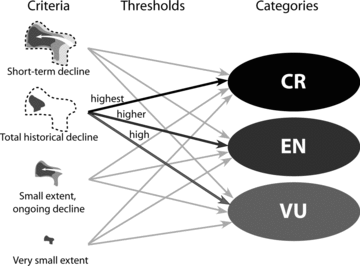Establishing IUCN Red List criteria for threatened ecosystems
- PMID: 21054525
- PMCID: PMC3051828
- DOI: 10.1111/j.1523-1739.2010.01598.x
Establishing IUCN Red List criteria for threatened ecosystems
Abstract
The potential for conservation of individual species has been greatly advanced by the International Union for Conservation of Nature's (IUCN) development of objective, repeatable, and transparent criteria for assessing extinction risk that explicitly separate risk assessment from priority setting. At the IV World Conservation Congress in 2008, the process began to develop and implement comparable global standards for ecosystems. A working group established by the IUCN has begun formulating a system of quantitative categories and criteria, analogous to those used for species, for assigning levels of threat to ecosystems at local, regional, and global levels. A final system will require definitions of ecosystems; quantification of ecosystem status; identification of the stages of degradation and loss of ecosystems; proxy measures of risk (criteria); classification thresholds for these criteria; and standardized methods for performing assessments. The system will need to reflect the degree and rate of change in an ecosystem's extent, composition, structure, and function, and have its conceptual roots in ecological theory and empirical research. On the basis of these requirements and the hypothesis that ecosystem risk is a function of the risk of its component species, we propose a set of four criteria: recent declines in distribution or ecological function, historical total loss in distribution or ecological function, small distribution combined with decline, or very small distribution. Most work has focused on terrestrial ecosystems, but comparable thresholds and criteria for freshwater and marine ecosystems are also needed. These are the first steps in an international consultation process that will lead to a unified proposal to be presented at the next World Conservation Congress in 2012.
©2010 Society for Conservation Biology.
Figures
References
-
- Abell R, et al. Freshwater ecoregions of the world: a new map of biogeographic units for freshwater biodiversity conservation. BioScience. 2008;58:403–414.
-
- Beechie TJ, Sear DA, Olden JD, Pess GR, Buffington JM, Moir H, Roni P, Pollock MM. Processed principles for restoring river ecosystems. BioScience. 2010;60:209–222.
-
- Benson JS. New South Wales Vegetation Classification and Assessment: introduction – the classification, database, assessment of protected areas and threat status of plant communities. Cunninghamia. 2006;9:331–382.
-
- Benson JS, Allen C, Togher C, Lemmon J. New South Wales Vegetation Classification and Assessment: part 1. Plant communities of the NSW Western Plains. Cunninghamia. 2006;9:383–451.
-
- Butchart SH, Akçakaya HR, Chanson J, Baillie J, Collen B, Quader S, Turner WR, Amin R, Stuart SN, Hilton-Taylor C. Improvements to the Red List Index. Public Library of Science ONE. 2007;2 DOI: 10.1371/journal.pone.0000140. - DOI - PMC - PubMed
Publication types
MeSH terms
LinkOut - more resources
Full Text Sources
Molecular Biology Databases


